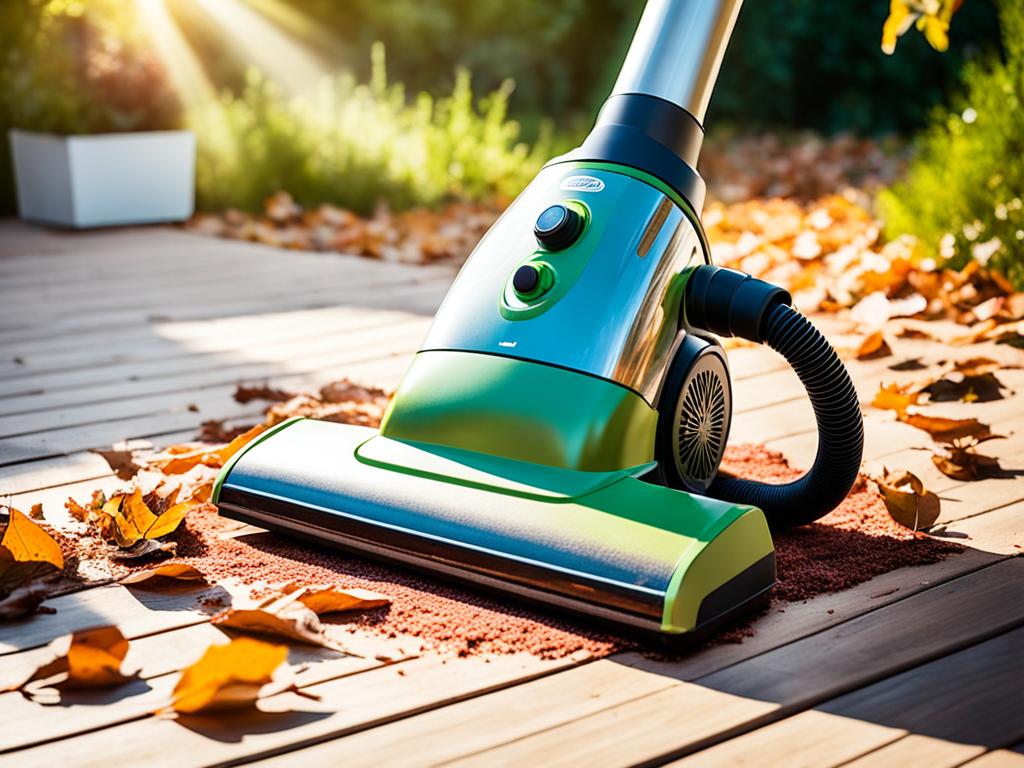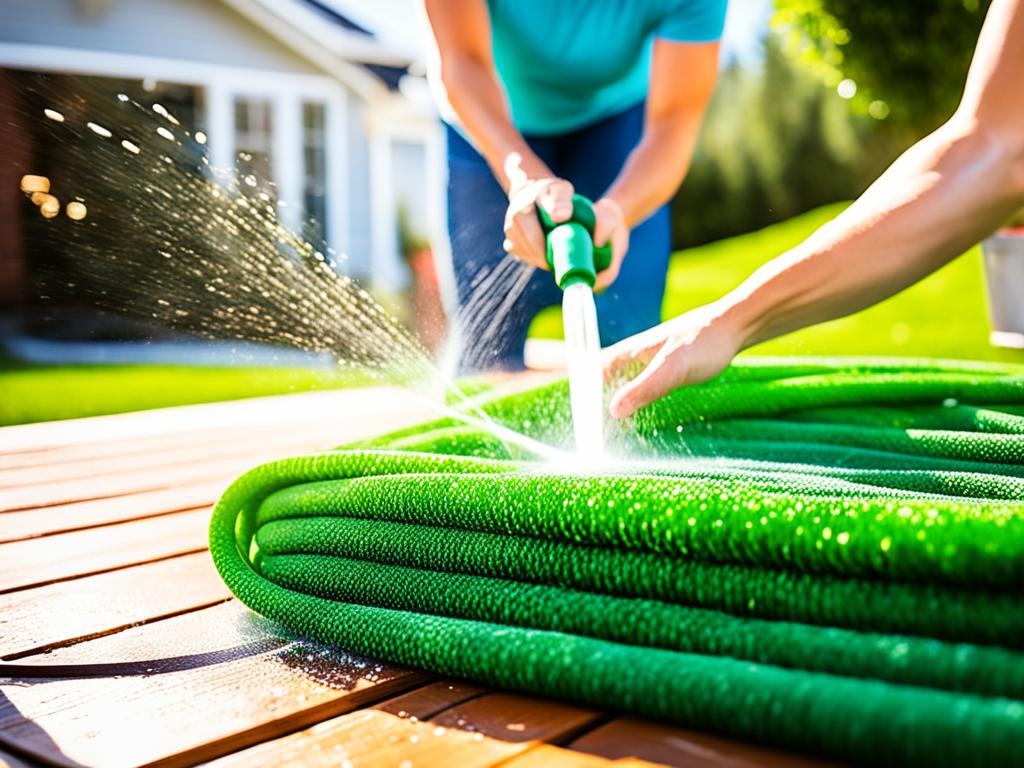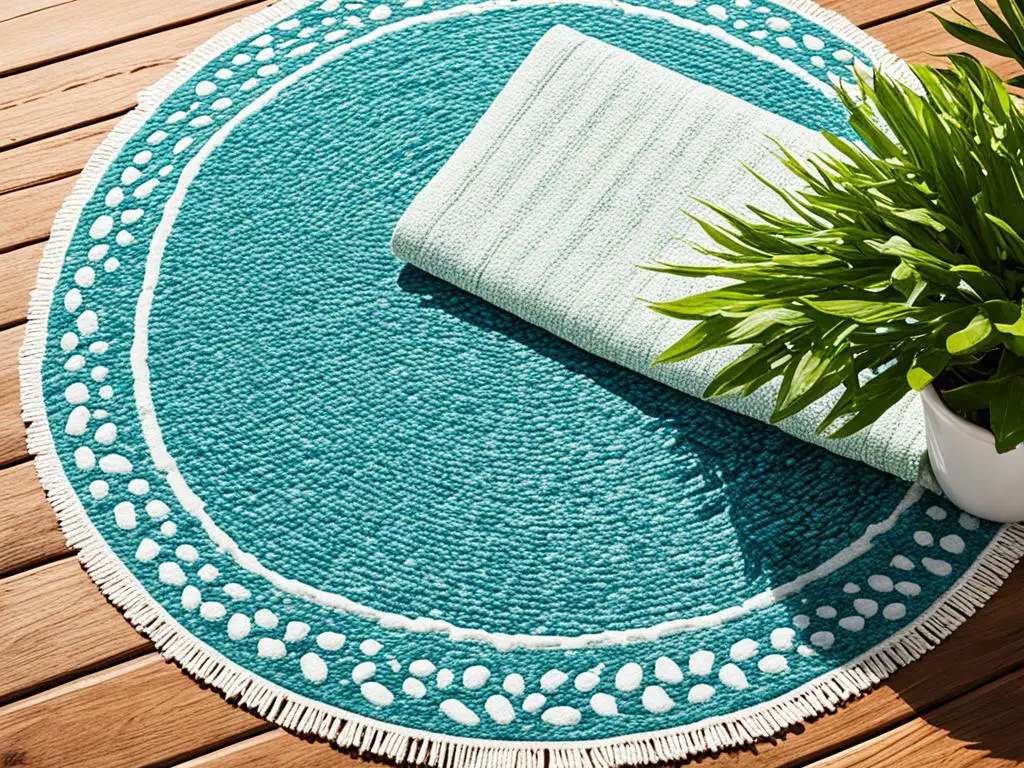When it comes to outdoor rugs, one of the most common concerns is whether they can handle getting wet. After all, outdoor rugs are exposed to various weather conditions, including rain. If you’re wondering about the water resistance and durability of outdoor rugs, you’re in the right place.
Outdoor rugs are typically made from synthetic materials that are designed to withstand dirt, moisture, and even sunshine. These materials are chosen for their ability to dry quickly and resist fading, ensuring that your outdoor rug stays looking vibrant and beautiful for a long time.
When it comes to cleaning and maintaining outdoor rugs, you’ll be happy to know that it’s a simple process. Regular maintenance includes shaking the rug to remove dirt and debris, vacuuming it on both sides to keep it free from dust and dirt, and even spot cleaning for smaller areas that need attention.
If your outdoor rug is in need of a deeper clean, you can also wash it with soap and water. This allows you to tackle any stubborn stains or dirt that may have accumulated over time. Just be sure to rinse the rug thoroughly and allow it to dry completely before using it again.
While outdoor rugs are designed to handle moisture, it’s always a good idea to store them during snowy months or when not in use for an extended period. This helps to preserve their condition and extend their lifespan.
So, can an outdoor rug get wet stress-free? The answer is yes! Outdoor rugs are specifically made to handle moisture and are built to last. With proper care and maintenance, you can enjoy your outdoor rug for years to come, rain or shine.
Key Takeaways:
- Outdoor rugs are made from synthetic materials that are water-resistant and durable.
- Regular maintenance includes shaking, vacuuming, and spot cleaning.
- Outdoor rugs can be washed with soap and water for a deeper clean.
- Storing the rug during snowy months is recommended.
- Proper drying techniques should be used to ensure the rug is completely dry before use.
How to Clean an Outdoor Rug: Shaking and Vacuuming
Keeping your outdoor rug clean is essential for maintaining its appearance and longevity. Regular cleaning not only removes dirt and debris but also helps to preserve the rug’s vibrant colors and patterns. In this section, we will explore two effective methods for cleaning your outdoor rug: shaking and vacuuming.
Shaking the Outdoor Rug
Shaking the outdoor rug is a simple yet effective way to remove loose dirt, debris, and crumbs. If your rug is small enough, you can take it outside and give it a good shake to dislodge any accumulated particles. This method works particularly well for rugs with a high pile or texture that can trap dirt easily. Make sure to shake the rug vigorously to ensure all debris is dislodged.
If your outdoor rug is too large to shake comfortably, don’t worry! There is still a solution. You can hang the rug vertically and use a stick or broom handle to gently beat the back of the rug. This will help loosen and remove any trapped dirt or debris. Be sure to hit the rug evenly across its surface to ensure a thorough cleaning.
Vacuuming the Outdoor Rug
Vacuuming is another effective method for cleaning outdoor rugs. Regular vacuuming helps to remove dirt, dust, and debris from both sides of the rug, ensuring it remains clean and well-maintained. To vacuum your outdoor rug, follow these simple steps:
- Start by removing any loose dirt or debris by shaking or beating the rug as mentioned earlier.
- Set your vacuum to the appropriate setting for outdoor rugs. If your vacuum has a height adjustment feature, adjust it to a level that allows the brush to glide smoothly over the rug’s surface.
- Vacuum the rug on both sides, making sure to cover the entire surface area. Pay special attention to high-traffic areas or areas where dirt is more likely to accumulate, such as entryways or under outdoor furniture.
- If your outdoor rug has a high pile or texture, use the vacuum’s brush attachment to remove dirt from the crevices effectively.
- Repeat this process regularly to keep your outdoor rug clean and free from dirt and debris.
Note: While vacuuming is suitable for most outdoor rugs, it may not be suitable for certain types of flatweave or low pile rugs. For these rugs, sweeping with a broom or using a carpet sweeper may be more effective in removing dirt and debris.
By regularly shaking and vacuuming your outdoor rug, you can ensure that it remains in pristine condition, free from dirt and debris. These simple cleaning methods are quick, easy, and effective, helping to maintain the beauty and durability of your outdoor rug for years to come.

Spot Cleaning an Outdoor Rug
When your outdoor rug has small areas that need cleaning, spot cleaning is an effective method to remove stains and maintain its pristine appearance. By following these simple steps, you can easily spot clean your outdoor rug and keep it looking its best.
To begin, start by removing any excess moisture or debris from the affected area. This can be done by gently shaking or brushing off the surface of the rug. By clearing away the loose particles, you can focus on the specific spot that requires cleaning.
Once the surface is free from debris, it’s time to blot the spot with a cleaning solution. Create a mixture of water and mild detergent, such as dish soap, in a clean bowl or bucket. Dip a clean sponge or cloth into the soapy water and gently blot the stained area. Avoid rubbing or scrubbing vigorously as this can damage the rug fibers.
Continue blotting the spot until the stain begins to lift. If the stain is particularly stubborn, you can try using a soft-bristled brush to lightly scrub the area in a circular motion. Remember to be gentle to prevent any damage to the rug fibers.
Once the stain has been successfully removed, rinse the spot with clean water. This helps to remove any soap residue and ensures that no cleaning solution is left behind. Use a clean sponge or cloth dampened with water to thoroughly rinse the area.
After rinsing, allow the rug to air dry completely. This is essential to prevent any moisture from getting trapped in the fibers, which could lead to mold or mildew growth. It is best to place the rug in a well-ventilated area, ideally under direct sunlight, to facilitate the drying process.

Spot cleaning your outdoor rug regularly can help prevent stains from setting in and keep your rug looking fresh and beautiful. By following these steps, you can easily remove small stains and maintain the overall cleanliness of your outdoor rug.
Washing an Outdoor Rug
Cleaning your outdoor rug regularly is essential to maintain its beauty and longevity. While spot cleaning can take care of small stains and spills, there comes a time when a deeper cleanse is needed. Washing your outdoor rug with water and soap can effectively remove dirt, grime, and other stubborn stains.
To wash your outdoor rug, follow these simple steps:
- Thoroughly wet the rug using a garden hose or buckets of water.
- Create a soapy solution by mixing a small amount of mild soap or outdoor rug cleaner with water.
- Using a soft scrub brush, lather the soapy solution into the rug, working it in gentle circular motions.
- Pay extra attention to heavily soiled areas and stubborn stains, using a bit more pressure if needed.
- Rinse the rug thoroughly with clean water, ensuring all soap residue is removed.
- For effective rinsing, you can use a garden hose or buckets of water.
- After rinsing, gently squeeze out any excess water from the rug.
- Finally, lay the rug flat on a clean, dry surface, preferably in a sunny area, allowing it to air dry completely.
It’s important to note that different outdoor rugs may require different cleaning methods. Always refer to the manufacturer’s instructions or guidelines for specific care instructions. Additionally, avoid using harsh chemicals or bleach, as they may damage the rug’s fibers.
Remember to always test any cleaning solution or method on a small, inconspicuous area of the rug first to ensure it doesn’t cause any discoloration or damage.
Cleaning your outdoor rug with water and soap not only helps keep it looking fresh and vibrant but also helps prolong its lifespan. Regular maintenance and cleaning can ensure your outdoor rug remains a beautiful and functional addition to your outdoor space.
Now that you know how to wash your outdoor rug, the next section will cover how to effectively clean an outdoor rug that has mold, mildew, or moss.

Cleaning an Outdoor Rug with Mold, Mildew, or Moss
Outdoor rugs made from synthetic materials are generally resistant to moss, mold, and mildew. However, if you notice any signs of these growths on your outdoor rug, it’s important to take prompt action to clean and prevent further damage.
One effective method to clean an outdoor rug with mold, mildew, or moss is to use bleach. Here’s how:
- Prepare a solution of bleach and water, using a ratio of one part bleach to three parts water. Make sure you use caution and protect your skin and eyes when handling bleach.
- Using a spray bottle, generously apply the bleach solution to the affected areas of the rug. Be sure to cover the mold, mildew, or moss completely.
- Allow the bleach solution to sit on the rug for about 15 minutes, ensuring it has enough time to penetrate the growths.
- After the designated time has passed, use a scrub brush or sponge to gently scrub the affected areas. This helps remove the mold, mildew, or moss from the rug fibers.
- Rinse the rug thoroughly with water to remove any remaining bleach or residue. Make sure you rinse it well to avoid any potential damage to the rug or surrounding areas.
Alternatively, if you prefer to use natural cleaners, you can create a mixture of baking soda and vinegar. Here’s how:
- In a bowl, mix equal parts baking soda and vinegar to form a paste-like consistency.
- Apply the paste to the areas with mold, mildew, or moss, ensuring full coverage.
- Allow the paste to sit on the rug for about 30 minutes, letting it work its magic.
- Using a scrub brush or sponge, gently scrub the affected areas to remove the growths from the rug fibers.
- Rinse the rug thoroughly with water to remove any residue.
Remember to always follow manufacturer’s instructions and test any cleaning solutions or methods on a small, inconspicuous area of the rug before applying them to the entire surface.
After cleaning the rug, make sure it is completely dry before placing it back in its intended area. Proper drying techniques, such as laying the rug flat in a sunny spot, can help prevent the recurrence of mold, mildew, or moss.
| Cleaning Option | Instructions |
|---|---|
| Bleach Solution | Prepare a solution of one part bleach to three parts water. Apply to affected areas. Allow it to sit for 15 minutes. Scrub with a brush. Rinse thoroughly. |
| Baking Soda and Vinegar | Mix equal parts baking soda and vinegar to form a paste. Apply to affected areas. Let it sit for 30 minutes. Scrub with a brush. Rinse thoroughly. |
Drying an Outdoor Rug
After cleaning your outdoor rug, the next step is to ensure it is properly dried before using it again. Drying the rug thoroughly not only prevents a damp and musty smell but also helps to maintain its longevity. Here are some essential tips for drying your outdoor rug:
- Lay the rug flat: Place the cleaned outdoor rug on a flat surface, preferably in a sunny area. This allows both the top and bottom of the rug to dry evenly and completely.
- Avoid folding or rolling the rug: To ensure proper drying, it’s crucial to avoid folding or rolling the rug while it’s still damp. This can result in mold or mildew growth.
- Use a drying machine: If you prefer a quicker drying process, you can use a drying machine or a fan. Make sure to follow the manufacturer’s instructions and set the machine to the appropriate temperature.
- Hang the rug: If you don’t have space to lay the rug flat, hanging it up can be an alternative. Use sturdy clips or clothespins to secure the rug to a clothesline or railing. Ensure that both ends of the rug are secured to prevent it from sagging.
Remember, it’s essential to allow the rug to dry completely before using it again. This helps to maintain its shape, prevent odors, and prolong its lifespan.
Conclusion
Proper outdoor rug care is essential for maintaining the beauty and longevity of your rugs. With the right techniques, you can easily keep your outdoor rugs clean and in great condition.
Regular shaking and vacuuming are effective ways to remove dirt and debris from your outdoor rugs. Spot cleaning is recommended for small stains, using a mixture of water and mild detergent. For a deeper clean, washing your outdoor rugs with soap and water is a simple and effective method.
During snowy months or when not in use, it’s advisable to store your outdoor rugs to protect them from harsh weather conditions. Additionally, proper drying techniques are crucial to prevent mold and mildew growth. Lay your rugs flat in a sunny area and ensure they are completely dry before using them again.
By following these tips for outdoor rug care, you can enjoy a beautiful and well-maintained outdoor space. Keep your rugs clean, fresh, and ready to withstand the elements for years to come.



